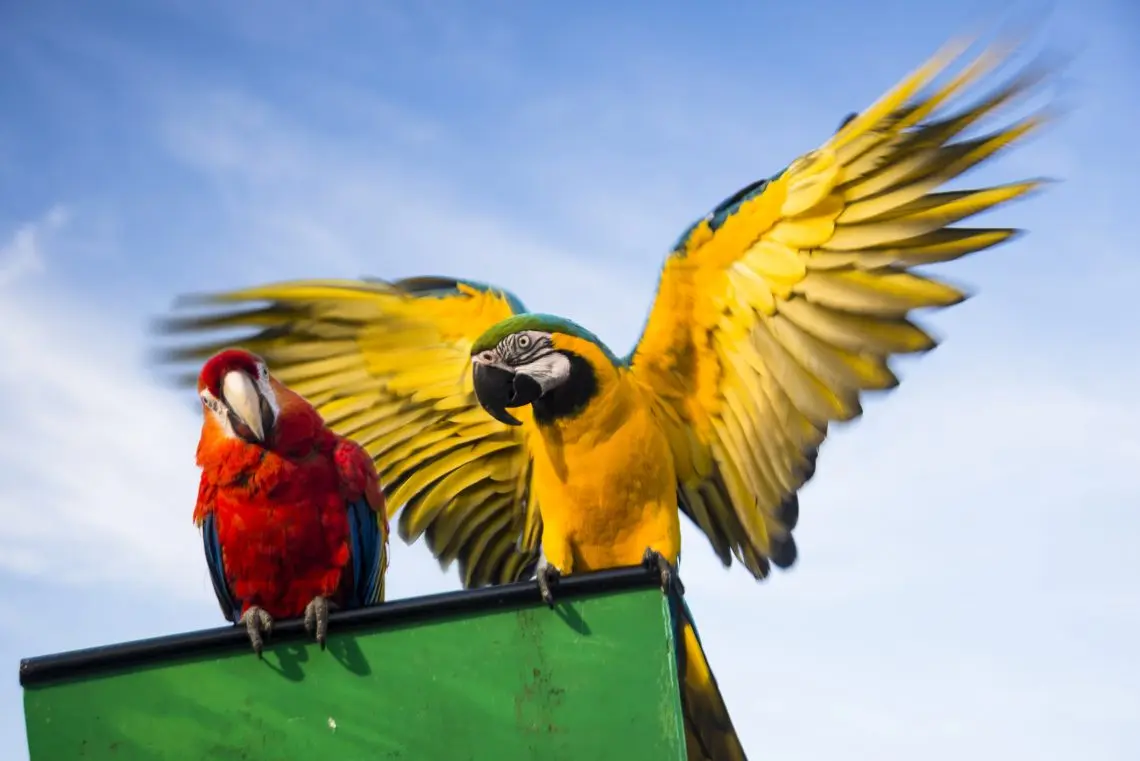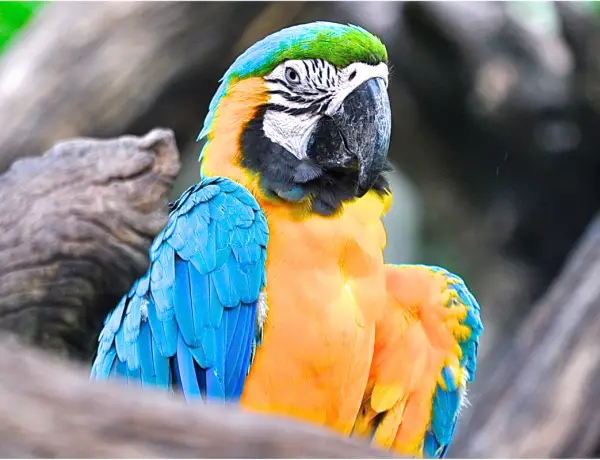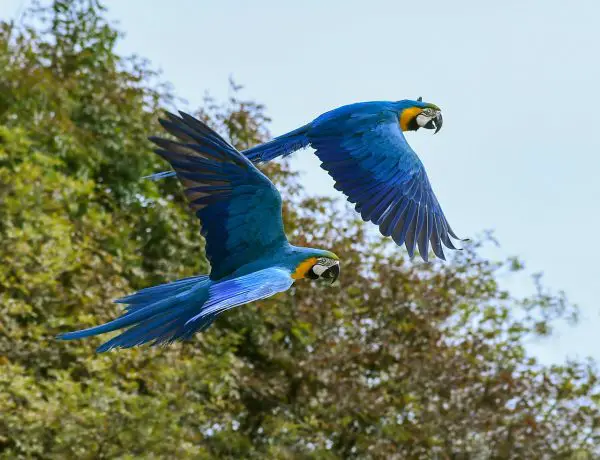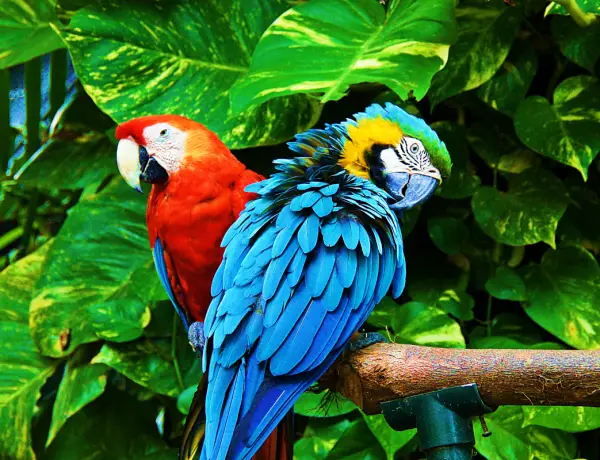Birds happen to be extremely intelligent pets on top of being easy to train. While it may seem that smaller birds would be easier to take care of, there are several birds that would make wonderful pets for the beginner, that range in different sizes, colors, lifespans, and personalities.
While it is important to enjoy the above aspects, there are also particular factors like common health conditions, social concerns, and abilities to consider. Among the many species of birds that exist, the following eleven birds rank at the top as the best birds for beginners due to their hardy natures, personalities, and low amount of medical concerns.
Table of Contents
Choosing One of the Best Types of Birds for Beginners
Birds can be fun and very social pets. Many birds enjoy having company, whether it be another bird of similar species or contact with their owner. If you want to get a bird, remember that it is only advised when you, or your family, are able to make ample time for it. Even being in the same room as their owner will keep many pet birds from getting stressed out and upset.
It is also important to note that many birds are highly sensitive to air pollutants, including cigarettes, cigars, and pipes, because of their respiratory system. The table below shares the top-recommended birds to adopt for beginners, their average lifespans, other known names, and common medical concerns for you to keep in mind.
| Type of Bird | Other Names | Average Lifespan | Common Medical Concerns |
|---|---|---|---|
| Cockatiel | Miniature Cockatoo, Weeros, Quarrions | 10-15 years | Infections, Parasites, Obesity, Fatty Liver |
| Domestic Canary | Harz Roller, Red Factor Canary | 10-15 years | Respiratory illness, Obesity |
| Finch | Society, Gouldian, Zebra | Up to 10 years | Respiratory illness, Mite infections |
| Rosy-Faced Lovebird | Rosy-collared Lovebird, Peach-faced Lovebird | 15-25 years | Respiratory illness, Yeast infections, Chlamydiosis |
| Parakeet | Budgies | 10-15 years | Infections, Fatty liver |
| Parrotlet | Pocket Parrots | 15-20 years | Yeast infections, Accidents |
| Hyacinth Macaw | Hyacinthine Macaw | 50-60 years | Pro-ventricular dilatation disease, Psittacosis, Papillomas |
| Conure | Depends on type | 20+ years | Avian Bornavirus |
| Quaker Parrot | Monk Parakeet | 15-20 years | Feather picking, Fatty liver |
| Pionus Parrot | Red-vented Parrot | 25-40 years | Fungal infections, Teflon Poisoning |
| Amazon Parrot | Yellow-naped Amazon, Orange- winged Amazon | 40-50 years | Obesity, Heart disease, Infected nares, Respiratory Illness |
1. Cockatiels
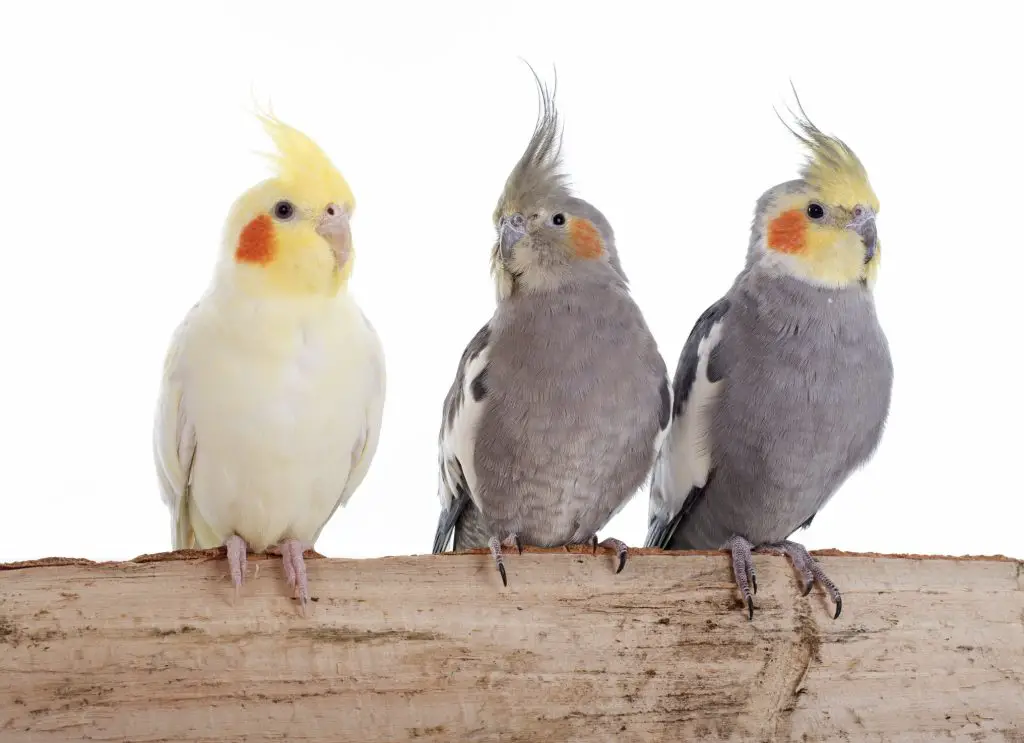
Homes: When deciding on a cage for your cockatiel, it will depend on how often they spend time out of their cage. If you plan to have them stay inside the cage the majority of the time, you will want to choose the largest enclosure you can afford and have space for. Cockatiels also tend to be messy eaters and will drop their food on the ground quite often. They are just as willing to eat food off the bottom of their cage as they are out of their feeder, so be sure to install a grate, so your cockatiel doesn’t accidentally eat its own droppings.
Diet: Wild cockatiels will eat anything from seeds and leaves to bark and insects. Since your cockatiel will not be as active as its wild cousins, they will need a slight variation in their diet. Cockatiels do well with a seed or pellet diet with a variety of fruits, veggies, and protein added to it.
Caution: Do not feed your cockatiel avocado, chocolate, fruit seeds, onions, garlic, alcohol, mushrooms, honey, salt, caffeine, dried/uncooked beans, rhubarb, high-fat, high-sugar, or high-sodium foods, or anything containing xylitol
Play Time: Remember that cockatiels love to play, so providing raffia strips, twig balls, and swings will keep your cockatiel entertained. When you decide which toys to get, make sure to rotate them out every so often to keep your feathery friend’s mind active.
Social Requirements: With the right care, cockatiels have very happy demeanors and are also naturally social and intelligent birds. Since cockatiels are smart, you can train your bird a variety of simple commands, like “step up,” as an example. By gently pressing your fingers under their chest area and saying, “step up,” your cockatiel will learn what you are expecting. Always repeat the command and practice regularly with positive reinforcement so your cockatiel can learn.
Vocal Types: Most cockatiels have a melodic and high-pitched voice, and they love to speak after waking up and before going to sleep. A talkative cockatiel is usually a good sign, as it shows that they are happy. Common sounds include whistling, chirps, squawks, and soft cheeps.
Fun Fact: Though cockatiels were discovered in Australia during the 1700s, they did not become popular until the Australian gold rush during the 1900s.
2. Domestic Canaries

Homes: Canaries love to fly, so when you choose a cage, it’s crucial to find one that is at least 16 inches wide by 24 inches long. If you can get a longer cage, it will allow your canary more space to fly around. Also, if you get a wired cage, the bars should be spaced no more than half an inch to keep your canary from getting its head stuck in between the bars.
Note: Canaries can become overheated when kept in direct sunlight. Keep your canary away from windows, a/c units, and drafts. If your bird is puffed up or has its mouth open and wings away from its body, then it is a sign it’s too cold or hot.
Diet: In most pet stores, you can find seed mixtures that are specifically designed with your canary in mind. Canaries also enjoy access to kale, broccoli, spinach, peas, and/or celery daily. As a treat, you can give small amounts of oranges, grapes, apples, and bananas. Be sure to provide fresh water for your canary every day, as canaries are very sensitive to dehydration.
Play Time: Unlike parrots, canaries don’t need as many toys and can survive with one toy, mirror, or a branch in their cage. They do require a lot of exercise, so keeping its home clear of excessive toys is best to allow your canary room to fly around. To help give your canary exercise, you can allow for up to an hour of supervised flight time out of its cage.
Social Requirements: Canaries are pretty low maintenance in general, and also when it comes to social requirements. They enjoy their space and love to live alone. As long as their basic necessities (food, water, and exercise) are met, they tend to be quite happy birds.
Vocal Types: Domestic canaries have a lovely melody that is often soft and pleasant to listen too. While there are different types of canaries, the male song canary was bred to sing. Other common sounds include chirps.
Fun Fact: Canaries are typically not picky eaters and enjoy the occasional treat. While it may sound odd, giving your canary a jalapeno pepper every now and then will be seen as a real treat. They are not only nutritional for them, but they are insensitive to the heat from the pepper as well!
3. Finches
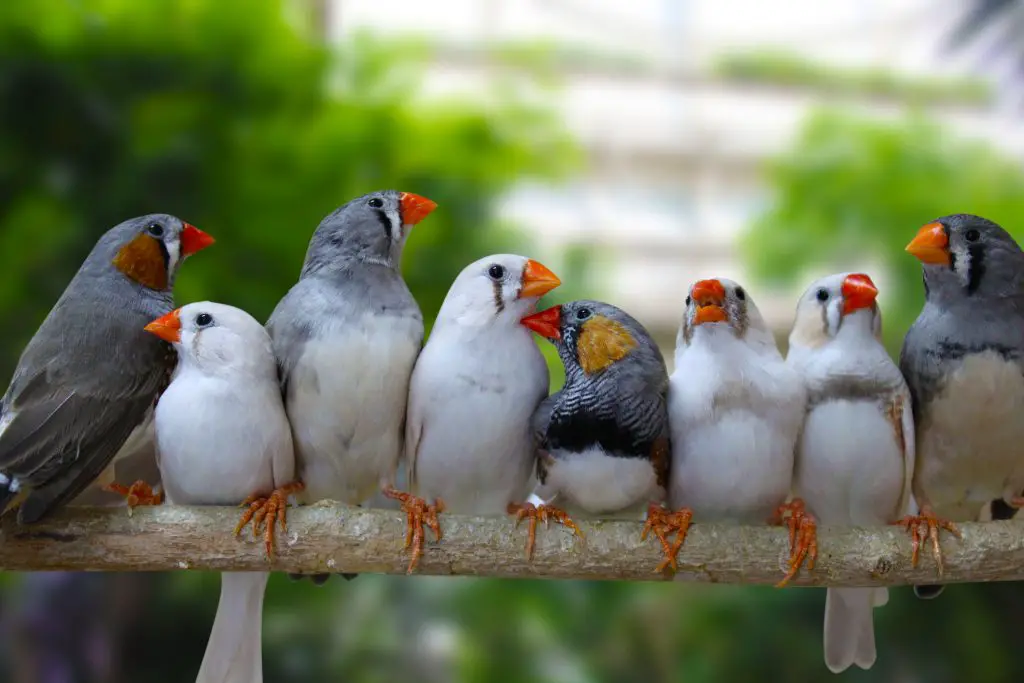
Homes: Finches tend to be more active than other domestic birds, so providing a long cage that allows them to fly is best. When deciding on a cage, the two most important pieces are the length of the cage and the bars being close enough together to prevent escape. Since they are natural escape artists, there are cages that you can find specifically designed to house a finch. The one I linked above with the canaries would also be ideal for finches with the adequate length and the bars being 3/8 of an inch apart.
Diet: The foundation of your finches’ diet should be a seed mixture. You can find special mixes created just for finches either at a pet shop or online. You can supplement your finches’ diet with most veggies and fruits in moderation. Be sure to stay away from lettuce, onion, avocado, rhubarb, and citrus fruits as they are toxic to finches.
Play Time: As long as your finch has room to fly, they are relatively happy birds. You can add rope ladders and perches to give them a variety of areas to climb and fly from. Be sure to leave a portion of the cage open to allow them to fly around and get exercise.
Social Requirements: Finches enjoy the company of other finches and tend to get lonely when kept on their own. By purchasing at least two, they will be able to enjoy each other’s company when you step out. While you can talk to your finch, they are not birds that can generally be trained and should be enjoyed from a distance.
Vocal Types: Finches have several different vocal sounds that vary based on what they’re trying to communicate with other finches. You can find an experiment that had been completed with zebra finches to show the different sounds that finches are known to have here.
Fun Fact: Since finches are naturally very social birds, they will typically socialize well with different species of birds.
4. Rosy-Faced Lovebirds

Homes: Lovebirds enjoy attention so they will want to spend their time with you. If you let your lovebird spend most of its time outside of the cage, a smaller cage will be acceptable. But, if your lovebird spends most of its time in its cage, a larger cage that it has room to fly around in would be best. For a single lovebird, an 18″ x 18″ x 18″ cage would suit them well. If you are getting more than one lovebird, you will want to get a more extended and taller cage. It may take a little bit of looking around, but you should also invest in a cage with horizontal bars instead of vertical, as this bird likes to spend its time climbing.
Diet: Female lovebirds tend to lay eggs even without a male around, which can cause calcium deficiency. By providing a balanced diet, you can provide the calcium needed for your lovebirds to not become lethargic. Lovebirds do best with a seed diet mixed with fruits and vegetables.
Play Time: Since your lovebird enjoys attention, it will want to spend time out of its cage and with you. The more attention you give your lovebird, the more friendly it will become. If you are unable to tend to your lovebird, they can become skittish and will need attention to break this habit. They also enjoy swings, leather strips, and twig balls.
Social Requirements: Lovebirds can survive alone but enjoy the company of a mate. By getting a set of lovebirds, your lovebirds will be able to socialize and bond together. However, be careful not to overcrowd the cage as lovebirds will bicker and begin to fight if there are too many in one cage.
Vocal Types: While lovebirds can get loud, they usually stick to chattering and whistling.
Fun Fact: The rosy-faced lovebirds tend to stay with one partner for life and will strengthen their bond by feeding each other after stressful periods or lengthy periods away from each other.
5. Parakeets
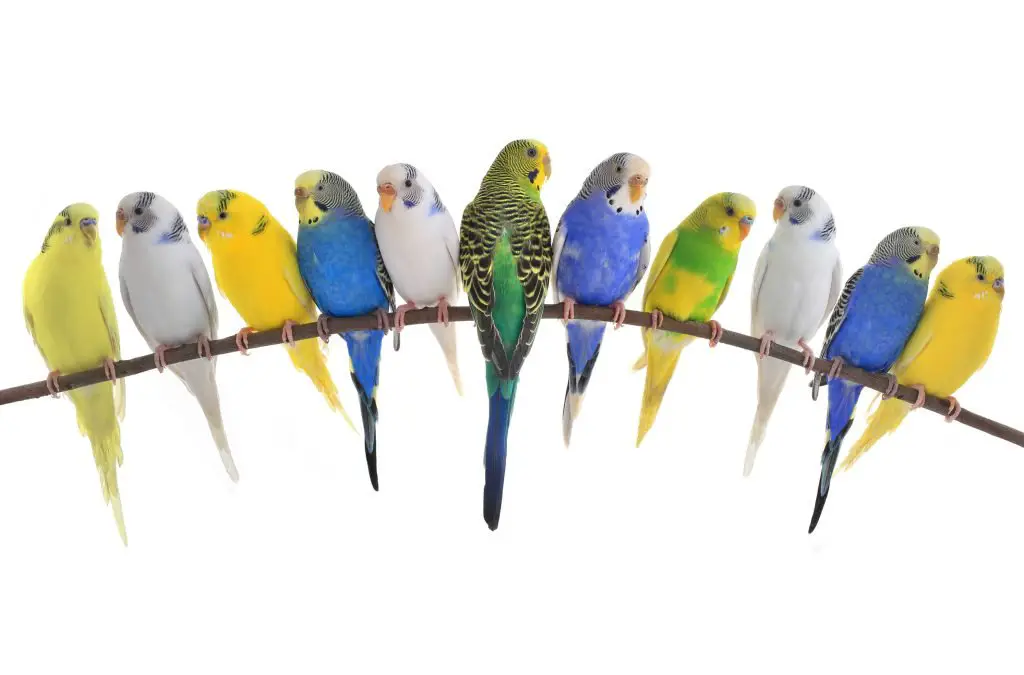
Homes: The size of the cage will depend on if you purchase one or two parakeets. For a single parakeet, anything over 20″ x 18″ x 18″ will suffice. If you have two parakeets, then the minimum size should be at least 30″ x 18″ x 18″. Be sure to get a cage that has the bars a maximum of ½” apart to keep your parakeet from getting its head stuck between the bars. Also, in order to absorb odors, you can put shredded newspaper at the bottom of your parakeet’s cage. While you may see some people put pine and cedar at the bottom of their cages for this purpose, they are actually toxic to parakeets.
Diet: Parakeets enjoy a variety of wet and dry food, so you will need to purchase two metal food bowls to keep their dry seeds and moist veggies apart. While you can put a water bowl in the cage, parakeets do better with water bottles customized for birds. By staying away from the water bowl, you will not need to deal with debris and droppings falling into your parakeet’s water. To provide adequate calcium, you can buy a cuttlebone for your bird to peck at.
Play Time: As an inquisitive bird, parakeets love to play. You can provide a variety of chew toys, puzzles, and foraging toys to keep them entertained. Toys to stay away from would be mirrors (depending on your birds’ personality) and toys with strings. Some parakeets tend to get overly attached to their reflection and will start to neglect their owners.
Social Requirements: By speaking to your parakeet frequently, he will begin to repeat what you say. Be sure to be careful what you say around your parakeet as he will catch and repeat most of what you say! Parakeets need to know that they will be safe in your care, so there will need to be time to build trust between you and your new friend. Start by putting your hand in the cage and keeping it still a few times a day and then adding a treat for him to come and inspect. Remember to keep your hand still until he becomes more comfortable.
Once your parakeet becomes more comfortable, you can teach him how to step up or perch on your finger so you can pet his head.
Vocal Types: Parakeets have a variety of sounds, including chirps, chattering, clicks, trills, whistle, singing, and repeating.
Fun Fact: The meaning of the word parakeet is “long tail” or “little wig,” depending on which origin of the word you think is correct. It is also another name for budgerigar (or budgies), which is the proper name for them where they come from – that being Australia.
6. Parrotlets
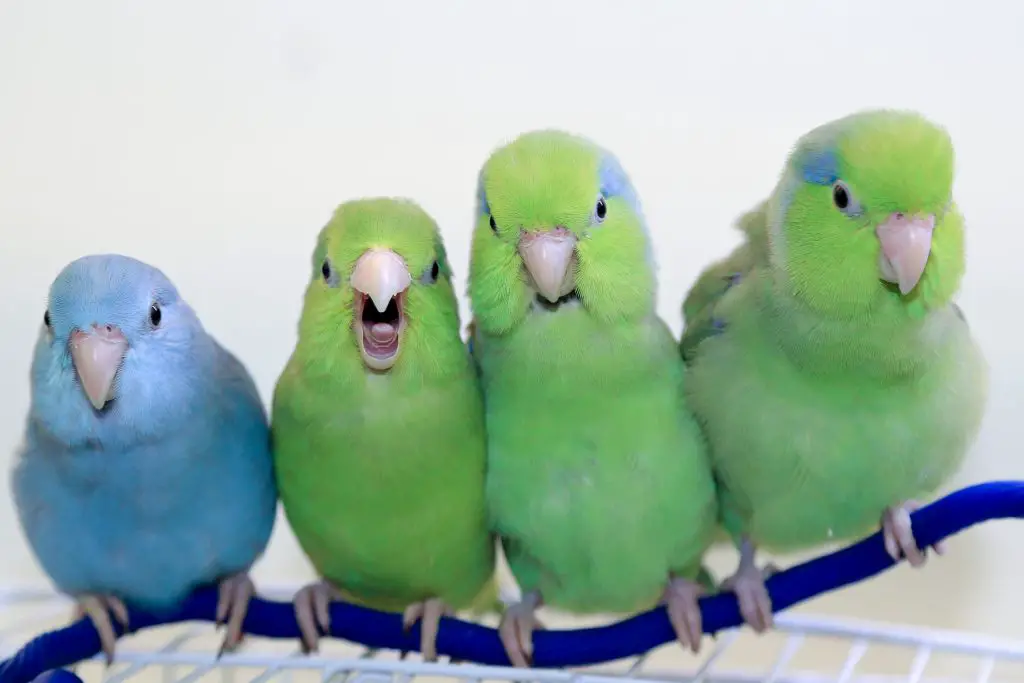
Homes: Parrotlets are some of the smallest birds in the parrot family. But, when it comes to their cages, the bigger the cage, the better. Be sure that bars are spaced no more than ¼” apart to keep your parrotlet from getting its head stuck. Also, by providing a larger cage for your parrotlet, you give them the opportunity to stretch their wings and fly around their enclosure. You can use aspen, shredded newspaper, or wood-pellets at the bottom of the cage.
Diet: A diet that is balanced between pellets with fresh fruits and vegetables works best for these active birds. You can also supply a cuttlebone to help as a source of calcium. Make sure to include fresh water or specialized water bottles for your parrotlet each day and be mindful not to give them too many treats as it can negatively affect their health.
Play Time: Since parrotlets are incredibly social birds, they enjoy playing with other parrotlets and their owners. By providing a fleece hut for your buddy, you can watch as they play hide-and-seek, but this also allows them some privacy. Parrotlets are very intelligent and can be taught multiple commands such as “step up” or “step down.” They also enjoy playing with puzzle toys, foraging toys, and squeakers.
Social Requirements: Parrotlets enjoy company and do best when they have a partner to spend their time with. These affectionate birds have personalities that are generally feisty, playful, and loving. If you want to bond with your parrotlet, then it would be best to only get one; otherwise, it will bond more closely to its mate and neglect its owner. Make sure to speak and pay attention to your parrotlet each day, so it is comfortable around humans.
Vocal Types: Like parakeets, parrotlets will mimic what they hear. However, they are not the best speakers in the parrot family and are much quieter than their parrot cousins.
Fun Fact: According to research published on National Geographic, parrotlets may actually name their babies!
7. Hyacinth Macaws

Homes: Since the macaws are rather large, most commercial cages will not provide enough space for them. Hyacinth macaws will do better when they have a large area devoted to them or when you set up part of your home for them, like a closed-in patio, full room, or a bird-proofed area. This will allow them to flap their wings and get the exercise that they need.
Diet: Hyacinth macaws have particular diets that consist mainly of palm nuts (which can be substituted with brazil nuts, walnuts, almonds, macadamias, coconut, and cashews). By choosing a high-fat macaw food, you can meet their dietary requirements without much worry.
Play Time: With their high intelligence, macaws love having a variety of toys available to choose from, including a mixture of puzzles, wooden toys, branches, and play trees. Also, while Hyacinth macaws tend to be very affectionate, it’s important to note that they tend to play rough with both their mate and human.
Social Requirements: Remember that macaws travel in groups and can get very lonely if they have too much time to themselves. They do best with a partner or with plenty of time around their owner. Be careful because even tame macaws can be nippy depending on their moods.
Vocal Types: Most macaws enjoy hearing their voices and can get very loud. They have the ability to learn a few words and phrases and will repeat their favorites, so be careful what you say around them! Since they are so smart, they can also learn to use certain words in the correct context.
Fun Fact: Macaws can fly up to 35mph.
Note: While Hyacinth macaws are not listed as endangered, they are listed as “vulnerable.” This means they have a dwindling population and may end up on the endangered list if some things do not change. As of the time this article was written, you can still purchase a Hyacinth macaw, albeit for an often hefty price. If you are unable to find one to adopt, a blue and gold or a blue-throated macaw would be my suggestions to look for.
8. Conures
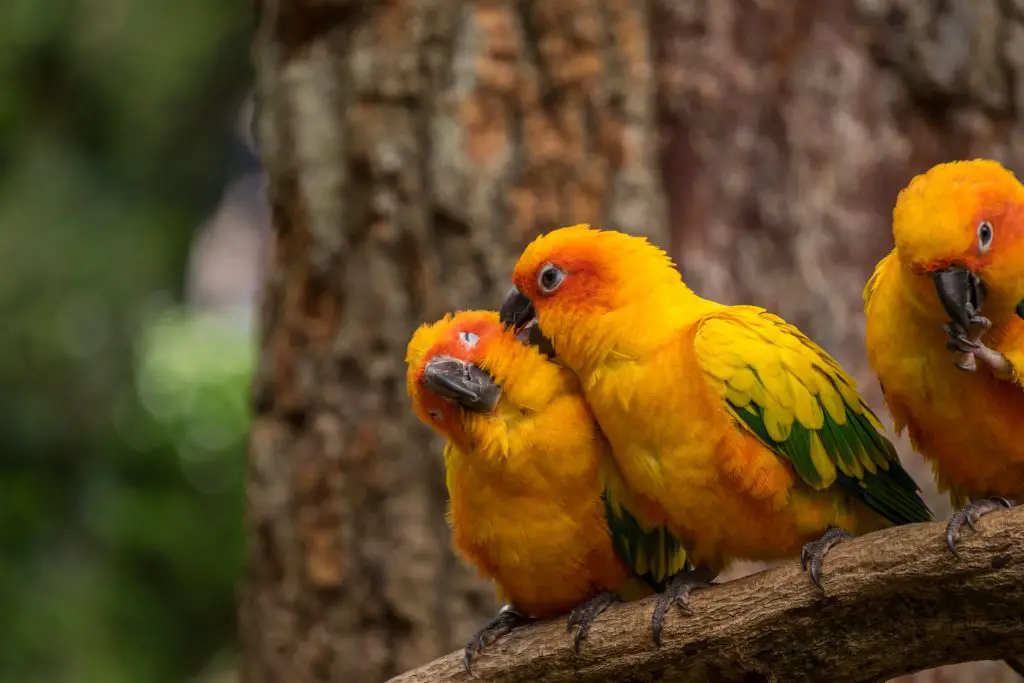
Homes: Since Conures enjoy moving around and playing with toys, a cage that is at least 36 inches long by 24 inches wide and 24 inches high would be a good starting point. They also love to take baths, so adding a large water dish or misting them with a spray bottle occasionally will allow them to fill this desire.
Diet: Conures’ diets should be a mixture of specialized pellets with fresh fruits and vegetables. They also enjoy treats in moderation. If your conure bathes in his water dish, then it’s important to change it out with clean water often.
Play Time: The main characteristic of conures is that they are very playful and curious. Conures love to be around people and can be a great family pet when children are taught how to appropriately interact with conures. They enjoy cuddling and will even dance around with their owners.
Social Requirements: Conures can be kept alone but should have daily interaction with their owners. A happy conure will enjoy cuddling and even climbing on its owner. Like other birds, conures may start off wary of their owner until trust is built up between the two.
Vocal Types: Conures can get extremely loud and display most of their emotions through a high-pitched screech. Though they are capable of talking, they don’t speak as well as other parrot species can. If your conure screeches, be sure not to run over to their cage because it may inadvertently enforce poor screeching habits.
Fun Fact: Conures typically enjoy mimicking sounds like whistles, doorbells, and even microwaves rather than words.
9. Quaker Parrots
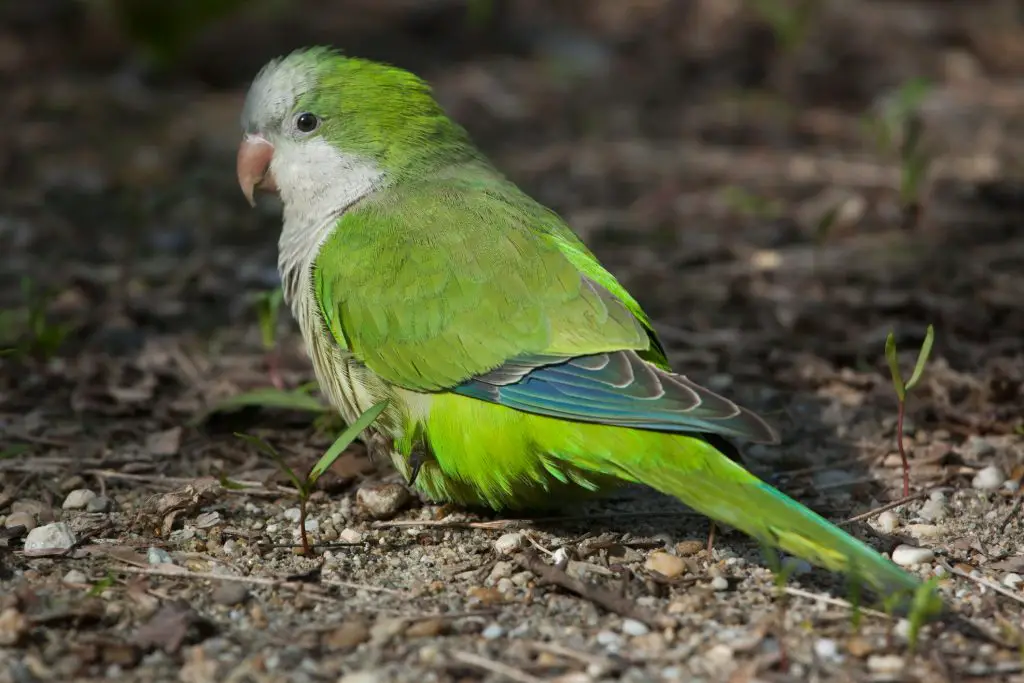
Homes: The minimum cage size for Quaker parrots should be 18″ x 18″ x 18″ with the bars spaced around 5/8″. Similar to other parrots, a larger cage is best because it allows them to move around and spread their wings. You can also provide safe material like branches, twigs, vines, shredded paper, and grass, so they can build nests.
Diet: Quaker parrots have a simple diet that can consist of a mixture of Avi-cakes, Nutri-berries, and pellets. Be sure to provide a special water bottle or a metal water dish with fresh water each day.
Play Time: The best toys are those that they can climb and swing on. You can put a mixture of swings, ladders, and bells into their cage, but be sure they also have room to fly around.
Social Requirements: Quaker parrots enjoy socializing with their owners and need daily interaction to remain happy and healthy. If they aren’t receiving enough attention, they can become extremely loud. They can also become very territorial with their owners.
Vocal Types: Quakers can be very loud from the moment they wake up to the point they fall asleep. They love to talk and have the ability to learn quite a few words and phrases.
Fun Fact: Many Quakers speaking abilities are on par with larger parrot species.
10. Pionus Parrots
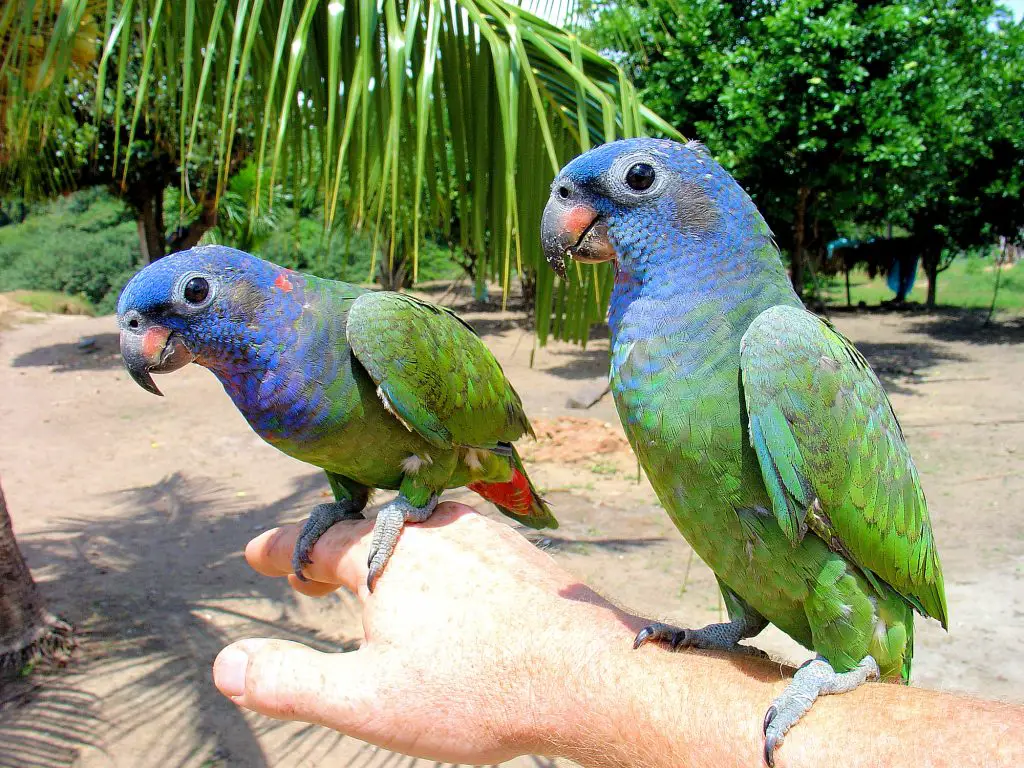
Homes: Pionus Parrots need a decent amount of room to move and spread their wings. The absolute minimum size for their cage is thought to be around 24″ x 24″ x 32″. Realistically, you would be better off getting one that is approximately 4-5 feet tall and 2-4 feet in length and width.
Diet: Pionus parrots do well with a diet that includes pellets, fresh fruits, and vegetables. They enjoy drinking water from either a water dish or water bottle and should be given fresh water daily. Treats can be enjoyed in healthy moderation.
Play Time: Pionus parrots are much less energetic than other parrots and don’t like to play very often. They will enjoy having different ladders, ropes, and wooden toys available in their cages to play with.
Social Requirements: Depending on how much attention you give your Pionus, will determine how standoffish they can be. They happen to be naturally aloof but can become sweet with enough attention from their owner. They can vary in personalities, so some may be more affectionate than others.
Vocal Types: Much quieter than other birds, the Pionus has a very easy-going attitude. They can be a bit standoffish, but there are times when they enjoy speaking and do so in a raspy voice.
Fun Fact: While not all Pionus parrots do, some may have a naturally sweet, musky odor.
11. Amazon Parrots

Homes: Amazon parrots require larger cages where they have room to fly around and also play with their toys. They must have enough room to exercise because the main issue with Amazon parrots is that they are prone to becoming obese.
Diet: Since Amazon parrots have a love for good food, they will beg for table food. Be careful not to give your parrot too much table food and provide them with a diet mixed with fresh fruits, vegetables, seeds, and pellets. Always provide fresh water each day for your parrot.
Play Time: Parrots generally love to play, so giving them an assortment of toys, including swings, wooden toys, and puzzles will keep them entertained for hours. They also enjoy roughhousing with their owners, so be careful when playing with them around children.
Social Requirements: Some Amazon parrots may seem moody and nippy, but with patience, the owner can learn certain behaviors to know if their Amazon doesn’t want to be held or needs space. They can sometimes get overwhelmed with too much playtime and need a cool-down session.
Vocal Types: Known for their fantastic speaking abilities, Amazon parrots are able to sing and speak a variety of words and phrases. They can get noisy but mostly when they are seeking attention or when they are happy from eating good food.
Fun Fact: They love to be the center of attention and to show off their amazing singing abilities for their owners.
Enjoy the Company of a New Pet Bird
By choosing a bird that meets your social and size requirements, as well as one with a personality that fits your lifestyle, you’ll be well on your way to many years of happy bird-parenting. Do you have a favorite bird to suggest for beginners? Let us know below!

